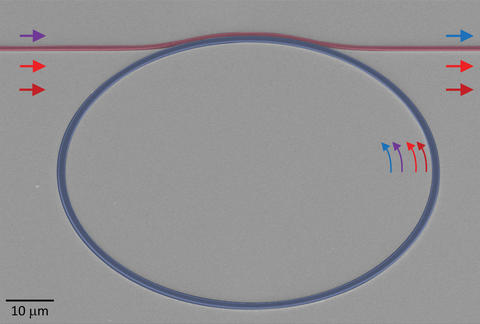
False-color scanning electron micrograph of a nanophotonic frequency converter, consisting of a ring-shaped resonator (shaded blue) into which light is injected using a waveguide (shaded red). The input signal, depicted as a purple arrow, is converted to a new frequency (blue arrow) through the application of two pump lasers (light and dark red arrows).
Converting a single photon from one color, or frequency, to another is an essential tool in quantum communication, which harnesses the subtle correlations between the subatomic properties of photons (particles of light) to securely store and transmit information. Scientists at the National Institute of Standards and Technology (NIST) have now developed a miniaturized version of a frequency converter, using technology similar to that used to make computer chips.
The tiny device, which promises to help improve the security and increase the distance over which next-generation quantum communication systems operate, can be tailored for a wide variety of uses, enables easy integration with other information-processing elements and can be mass produced.
The new nanoscale optical frequency converter efficiently converts photons from one frequency to the other while consuming only a small amount of power and adding a very low level of noise, namely background light not associated with the incoming signal.
Frequency converters are essential for addressing two problems. The frequencies at which quantum systems optimally generate and store information are typically much higher than the frequencies required to transmit that information over kilometer-scale distances in optical fibers. Converting the photons between these frequencies requires a shift of hundreds of terahertz (one terahertz is a trillion wave cycles per second).
A much smaller, but still critical, frequency mismatch arises when two quantum systems that are intended to be identical have small variations in shape and composition. These variations cause the systems to generate photons that differ slightly in frequency instead of being exact replicas, which the quantum communication network may require.
The new photon frequency converter, an example of nanophotonic engineering, addresses both issues, Qing Li, Marcelo Davanço and Kartik Srinivasan write in Nature Photonics. The key component of the chip-integrated device is a tiny ring-shaped resonator, about 80 micrometers in diameter (slightly less than the width of a human hair) and a few tenths of a micrometer in thickness. The shape and dimensions of the ring, which is made of silicon nitride, are chosen to enhance the inherent properties of the material in converting light from one frequency to another. The ring resonator is driven by two pump lasers, each operating at a separate frequency. In a scheme known as four-wave-mixing Bragg scattering, a photon entering the ring is shifted in frequency by an amount equal to the difference in frequencies of the two pump lasers.
Like cycling around a racetrack, incoming light circulates around the resonator hundreds of times before exiting, greatly enhancing the device's ability to shift the photon's frequency at low power and with low background noise. Rather than using a few watts of power, as typical in previous experiments, the system consumes only about a hundredth of that amount. Importantly, the added amount of noise is low enough for future experiments using single-photon sources.
While other technologies have been applied to frequency conversion, "nanophotonics has the benefit of potentially enabling the devices to be much smaller, easier to customize, lower power, and compatible with batch fabrication technology," said Srinivasan. "Our work is a first demonstration of a nanophotonic technology suitable for this demanding task of quantum frequency conversion."
This work was performed by researchers at NIST's Center for Nanoscale Science and Technology.
Q. Li, M. Davanço and K. Srinivasan. Efficient and low-noise single-photon-level frequency conversion interfaces using silicon nanophotonics. Nature Photonics, 18 April 2016. DOI: 10.1038/nphoton.2016.64

